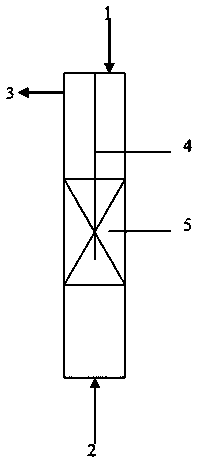Preparation method of bisphenol F
A phenol and feed technology, applied in the field of bisphenol F preparation, can solve the problems of short catalyst life, many side reactions, low product yield, etc., to increase the probability of contact and mass transfer efficiency, improve reaction efficiency and conversion rate , Improve the effect of condensation reaction conversion rate
- Summary
- Abstract
- Description
- Claims
- Application Information
AI Technical Summary
Problems solved by technology
Method used
Image
Examples
Embodiment 1
[0032] 1. Preparation of modified ion exchange resin catalyst: a: Wash 150 grams of styrene-based strongly acidic cation exchange resin with deionized water for 5 times, each time for 10 minutes, and dry it in a vacuum oven at 90°C for 4 hours; b: Put the dried strongly acidic cation exchange resin into a 2mm thick steel mesh bag, lay it flat on an ultrasonic vibrator with a vibration frequency of 59kHz, spray phosphotungstic acid aqueous solution with a mass percentage of 40% and nitrogen with an atomizing nozzle Immerse for 2 hours, the spray distance is 1cm, and the spray pressure is 0.05MPa; c: After washing, put it in a vacuum oven for 6 hours at 90°C, and bake the dried ion exchange resin at 210°C for 8 hours; d: Then put The resin is treated with 20% phosphotungstic acid aqueous solution according to the method of b, after washing, it is dried in a vacuum oven at 80°C for 6 hours, and the dried ion exchange resin is calcined at 200°C for 8 hours to obtain the supported ...
Embodiment 2
[0035] 1. Preparation of modified ion exchange resin catalyst: a: Wash 150 grams of styrene-based strongly acidic cation exchange resin with deionized water for 5 times, each time for 10 minutes, and dry it in a vacuum oven at 90°C for 6 hours; b: Put the dried strongly acidic cation exchange resin into a steel mesh bag with a thickness of 3mm, lay it flat in an ultrasonic vibrator with a vibration frequency of 58kHz, spray phosphotungstic acid aqueous solution with a mass percentage of 35% and nitrogen with an atomizing nozzle Immerse for 2 hours, the spray distance is 2cm, and the spray pressure is 0.07MPa; c: After washing, put it in a vacuum oven for 6 hours at 90°C, and bake the dried ion exchange resin at 210°C for 8 hours; d: Then put The resin is treated with 20% phosphotungstic acid aqueous solution according to the method of b, after washing, it is dried in a vacuum oven at 80°C for 6 hours, and the dried ion exchange resin is calcined at 200°C for 8 hours to obtain t...
Embodiment 3
[0038] 1. Preparation of modified ion exchange resin catalyst: a: Wash 150 grams of styrene-based strongly acidic cation exchange resin with deionized water for 5 times, each time for 10 minutes, and dry it in a vacuum oven at 90°C for 6 hours; b: Put the dried strongly acidic cation exchange resin into a steel mesh bag with a thickness of 3 mm, lay it flat on an ultrasonic vibrator with a vibration frequency of 57 kHz, spray phosphotungstic acid aqueous solution with a mass percentage of 45% and nitrogen with an atomizing nozzle Immerse for 2 hours, spray distance 2cm, spray pressure 0.06MPa; c: After washing, dry in a vacuum oven at 90°C for 6 hours, and bake the dried ion exchange resin at 210°C for 8 hours; d: Then put The resin is then treated with 15% phosphotungstic acid aqueous solution according to the method b, after washing, it is dried in a vacuum oven at 80°C for 6 hours, and the dried ion exchange resin is calcined at 200°C for 8 hours to obtain the supported het...
PUM
 Login to View More
Login to View More Abstract
Description
Claims
Application Information
 Login to View More
Login to View More - R&D
- Intellectual Property
- Life Sciences
- Materials
- Tech Scout
- Unparalleled Data Quality
- Higher Quality Content
- 60% Fewer Hallucinations
Browse by: Latest US Patents, China's latest patents, Technical Efficacy Thesaurus, Application Domain, Technology Topic, Popular Technical Reports.
© 2025 PatSnap. All rights reserved.Legal|Privacy policy|Modern Slavery Act Transparency Statement|Sitemap|About US| Contact US: help@patsnap.com


